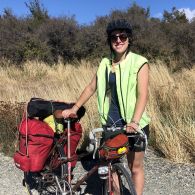A sustainable solution for Timaru's slippery tiles
Who is Imogen McRae and how is her project related to Sustainable is Attainable?

Imogen is a third-year University of Canterbury School of Product Design student on a mission to combat climate change.
When deciding on a topic for her final year project, she came across a proposal closely aligned to her passion; it read:
"We are seeking a student to explore opportunities for using by-products and waste streams produced by the South Canterbury food processing and manufacturing industry, to deliver products which create an attractive urban environment in Timaru."
This proposal was developed by Ria Chapman and Jennifer Crowther from the UC Biomolecular Interaction Centre, who work closely with us on the Sustainable is Attainable initiative.
Another key R&D organisation involved with Sustainable is Attainable is AgResearch, who are sponsoring Imogen's project. AgResearch are involved in the Building Better Homes, Towns and Cities (BBTHC) National Science Challenge, and have a vision to "create built environments that build communities".
Where did the idea for 'waste material pavers' come from?

With all this in mind, the next step was to invite Imogen to Timaru, so she could get familiar with our wonderful seaside city and determine the most appropriate element of the urban environment to improve.
This was the perfect opportunity to take a look at some of the waste materials that could be useful for achieving her objectives, while also talking to key stakeholders about the relevant issues being faced by our local community.
The timing was perfect, as the Timaru District Council (TDC) had recently completed the community engagement phase for their City Hub Strategy. The TDC team were more than happy to talk through the results with Imogen, and help to guide her research in a productive direction.
When reading through the feedback, it became evident to Imogen that the CBD's slippery tiles were seen as an issue for a number of Timaru residents. Along with the availability of waste materials to address this issue, it looked like Imogen was onto a winning combination, so down that path she went!
Imogen then headed back to Christchurch to get testing underway with a variety of waste samples. She was particularly interested in diatomaceous earth (DE), a by-product from the beer brewing industry, and DB Breweries kindly offered up samples. Her testing uncovered that polypropylene plastic waste (an issue for many in the Sustainable is Attainable collective), could be blended with the DE to create some solid non-slip paver prototypes to work with.
How has the Timaru community been involved?

Imogen returned to Timaru a few weeks later, to get some design assistance from the community on her paver patterns. She set up a station on Strathallan Corner and invited passers-by to get creative with the prototype tiles.
She was thrilled with the feedback, and took some great ideas away to form the final phase of engagement: the design survey. She received a fantastic 162 responses (99 were from Timaru residents, and the remainder from interested visitors).
What's next for the project?
Imogen is currently preparing her final project submission and will be undertaking a summer research programme with AgResearch, starting late November 2021. This will give her the opportunity to further test materials and identify the best way forward for their design (and any implementation in Timaru's streets)!
She is also working directly with Timaru District Council, keeping them up to date on progress and finding out the best approach for relevant local testing down the track.
We've loved being involved in this awesome piece of research to date, and look forward to seeing the outcomes of Imogen's summer research.
A big thank you to the University of Canterbury, AgResearch and of course Imogen for their efforts in creating a safer and more attractive urban environment for Timaru!